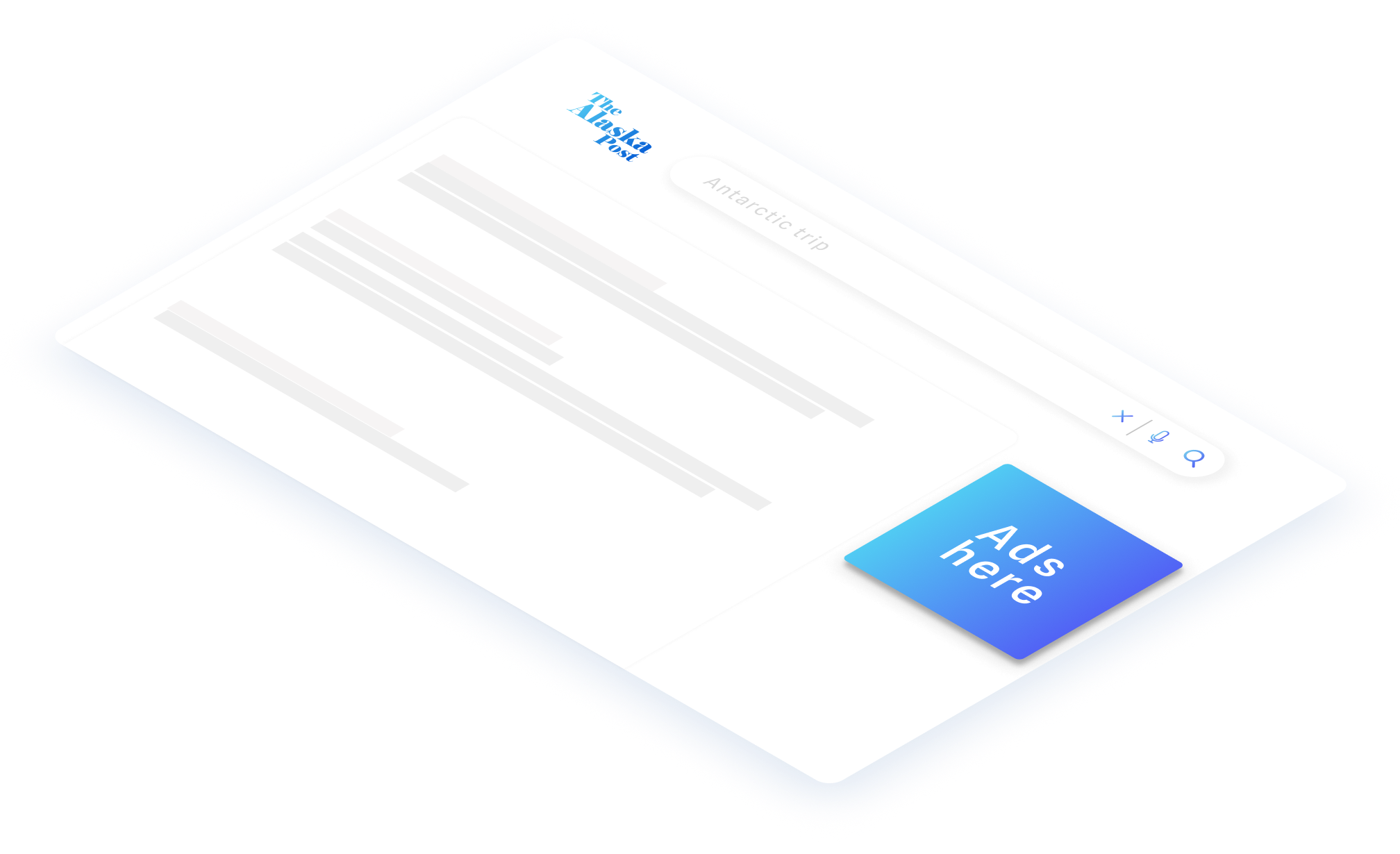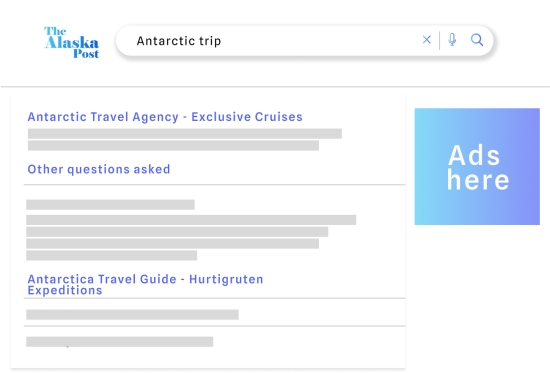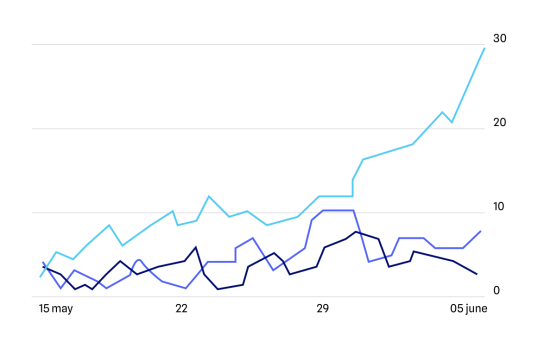
Display Ads: The Guide to Launching Your Display Campaign
Display Ads are a form of digital advertising displayed on targeted websites, usually through an advertising network. Here’s everything you need to know about this display format.

What are online display ads?
What are display ads?
Display ads are a form of online advertising. They’re the digital equivalent of physical billboards on the street or ads in magazines. Web display ads are displayed in dedicated spaces on various websites, chosen based on their relevance to the advertiser’s activity and/or the products and services they want to promote. They can take various forms: classic horizontal or vertical banners, mega banners, web skins, as well as static images, animated GIFs, and videos… They are one of the most well-known and widely used advertising formats. It is an integral part of the “display” category, which encompasses all forms of visual advertising.

What are the advantages of display ads?
Online advertising is one of the most powerful tools in marketing, and display ads are a prime example. It allows for targeted placement on a web page to attract the attention of internet users and pique their interest, without being as intrusive as a pop-up window or a pre-roll video. This type of advertising helps increase visibility, brand recognition, and sales, without negatively impacting the advertiser’s brand image. Moreover, advertising networks (which distribute ads across their network of websites) provide precise targeting criteria and sophisticated performance measurement tools. Lastly, creating display ads is relatively easy compared to other formats, making it accessible even to small businesses.
Display ads: what are the objectives?
Digital ads and display ads have very similar objectives. Below are some examples:
-
Increasing visibility
Occupying web space with display ads allows for exposure to internet users and the promotion of products and services.
-
Enhancing brand recognition
Crafting original and impactful banner ads contributes to boosting the advertiser’s brand recognition and enhancing their brand image.
-
Generating sales
When done effectively, by showcasing products and services and incorporating a compelling call-to-action, this type of advertising helps drive sales.
Display ads: what are the limitations?
Despite the benefits of this form of digital advertising, it’s important to consider its limitations. Display ads can be blocked by ad blockers (tools which are becoming increasingly popular), rendering them ineffective. Additionally, a new phenomenon known as “ad blindness” has arisen, where internet users have developed a habit of “ignoring” display advertisements displayed on web pages. This situation has led advertisers to explore other formats like native advertising. Furthermore, measuring the performance of display advertisements is not always straightforward, as users may not click on them immediately and may make purchases later.

Good to know
The concept of display ads is closely tied to that of the “publisher,” which refers to the website on which the advertisement will be displayed. The choice of the publisher and the purchased advertising space is crucial as it determines the relevance between the web page and the ad. For example, a windshield repair service would benefit from displaying its advertisement on an automotive website.
-
80%
of digital advertising
is represented by Search and Social. -
41%
of internet users
between the ages of 16 and 29 use an adblocker. -
13%
of advertising formats
in 2019 is “display advertising”.
Display ads and their role in advertising strategy
The role of display ads in advertising strategies
Display advertising is experiencing double-digit annual growth and generates investments worth billions of pounds. This market is primarily driven by display advertising and increasingly by its “programmatic” dimension (automated purchase of ad space). However, the presence of web display ads tends to decline over time in favour of formats that better align with users’ expectations, such as native advertising and Google Ads. The increasing popularity of mobile browsing further complicates matters due to limited screen space. In this context, advertisers are increasingly exploring combinations of display ad usage with other advertising formats to maximise effectiveness.

Different types of display ads
-
Classic banner
This horizontal format was among the first to appear on the web and continues to be widely used today.
-
Mega banner
The mega banner has gained prominence with the development of high-resolution screens. This format offers an excellent balance between visibility and intrusion.
-
Skyscraper
The “skyscraper” is a vertical format displayed on the side sections of a web page. It allows for showcasing images in a “portrait” orientation.
-
Pavement banner
One of the most popular formats used by major editorial websites, the pavement banner offers high visibility due to its central placement on the web page.
-
Square banner
The square banner, smaller than the pavement format, integrates more seamlessly into a web page, typically positioned alongside content.
-
Web skin
This giant banner displays as a background on a web page, covering a significant area that includes the header and side sections.
Display ads and native advertising
Display advertising is a key component of digital marketing. It’s the type of advertising that’s easily recognisable, typically consisting of an image, text, and a call-to-action. Display advertising encompasses various formats, including banners, contextual ads (pop-ups), interstitial ads (shown during web page loading), and videos (like YouTube pre-roll ads). However, as internet users increasingly reject these types of ads, it’s important to combine them with more seamlessly integrated advertising formats, such as native advertising. Native ads are designed to blend in with the web page they appear on, adopting its visual elements (colours, fonts, image sizes, etc.). They are less intrusive and almost invisible, but they may have a lower conversion potential. Therefore, employing both formats in a complementary way can be beneficial.


Different types of advertising
-
Social media advertising
Advertisers pay to display ads on social media networks, specifically within users’ news feeds, targeting their browsing and purchasing habits.
-
Sponsored advertising
Ads appear at the top of search engine results as regular links, distinguishable from organic links by a specific label.
-
Recommended lists
Products are prominently featured on e-commerce result pages with a “sponsored” label, particularly on marketplaces like Amazon.
-
Sponsored content
Sponsored content takes the form of articles, videos, or podcasts and aims to inform the internet user while seamlessly integrating with the platform.
-
Branded content
Similar to sponsored content, branded content directly promotes a brand’s products and services.
-
Product placement
Products are subtly or overtly integrated into unrelated content such as films, video games, music videos, and more.
-
39%
the percentage
of display formats in video form -
90%
the percentage
of internet users reached by Google’s Display Ad Network -
61%
of display advertising
is programmatic
How to launch your display ads campaign
An advertising campaign = a strategy tailored to your needs
Creating a successful display ad campaign requires a tailored strategy that meets your specific needs. Are you looking to create your own display ads? Do you want your products to be displayed on Google partner sites, reaching a wide audience and boosting your sales? To achieve this, you need to develop an advertising strategy that aligns with your goals and business objectives. This will enable you to make the most of digital advertising, which can be combined with other formats like native advertising. Seeking the expertise of a specialised digital agency can greatly assist you in launching a campaign that can truly make a difference.

Creating your display ads

-
STEP 1
Outline your advertising strategy
Start by determining the objectives of your campaign, whether it’s visibility, brand awareness, increased conversions, or sales. Next, identify your target audience: what are their needs? What issues should your display ads address? Make use of targeting criteria provided by advertising networks.
-
STEP 2
Determine your pricing model
The pricing model for online advertising depends on the format and advertising network. Different models include cost per thousand impressions (taking into account the number of ad views), cost per click (based on auction systems), cost per action (when the user completes a predetermined action), and cost per lead (focused on acquiring new prospects).
-
STEP 3
Evaluate your advertising budget
The budget for a display campaign depends on your business objectives and target market. Factors such as the human resources required, the chosen ad formats (what type of display ads), the advertising platform’s pricing model, and the duration of the campaign influence the budget.
-
STEP 4
Design your advertising campaign
What will your display ads look like? This step involves determining the visual elements of your display ads. To create an engaging ad, consider both the challenges your target audience faces and how your product or service can address them. Combine captivating images, compelling text, eye-catching colours, and a clear call-to-action to capture attention effectively.
-
STEP 5
Create your display ads
The creation phase involves producing a specific brief for each aspect of the advertising ad. Each brief is intended for the creatives who will create the ad: editorial guidelines for the copywriter, branding guidelines for the designer, technical specifications for the developer, and so on.
-
STEP 6
Distributing your display ads
Once the ads are ready, the next step is to find the right publishers – or to engage with advertising networks that have their own networks of websites and applications, such as Google. Take the time to test your display ads before distributing them. Once the campaign is launched, don’t forget to track its performance.
Any questions?
Display ads are a type of online advertisement. They are prominently displayed on web pages with the aim of attracting the attention of internet users and encouraging them to click. Display ads target various objectives, including visibility, brand awareness, and increasing sales.
There is typically a distinction between “display” advertising, which includes display ads and appears on a web page in a more or less intrusive manner, and “native” advertising. Native advertising is integrated into the content of the website where it is displayed and seeks to blend in with the surroundings. These two advertising formats can be used in a complementary manner.
Creating a display ad campaign involves following a series of steps: defining the strategy, determining the most suitable pricing model, evaluating the available budget, designing the campaign, creating the display ads (format, content, call-to-action…), and then distributing them to different publishers or through advertising networks.








